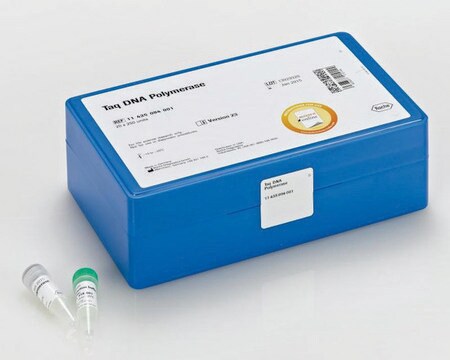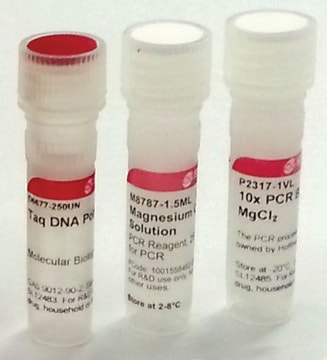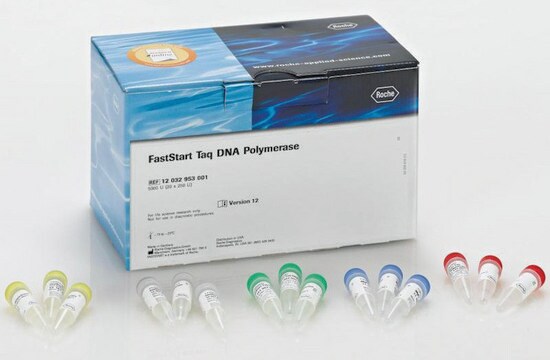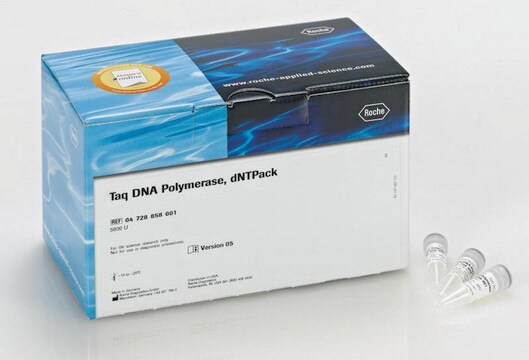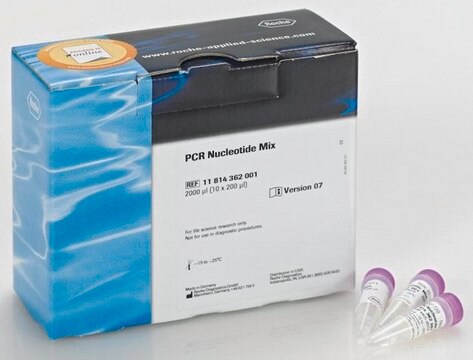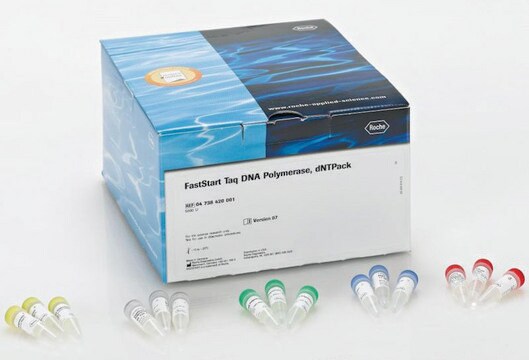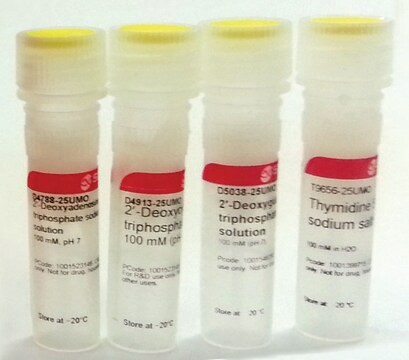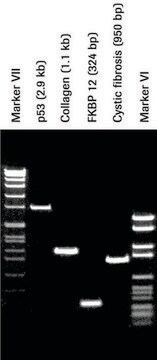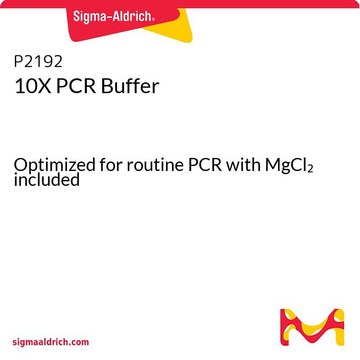TAQL-RO
Roche
Taq DNA Polymerase, 1 U/μl
suitable for PCR, hotstart: no, dNTPs included: no
Synonyme(s) :
dna amplification, pcr, polymerase, primer extension
About This Item
Produits recommandés
Source biologique
bacterial (Thermus aquaticus BM)
Niveau de qualité
Produit recombinant
expressed in E. coli
Forme
liquid
Utilisation
sufficient for ≤2,000 reactions (11647687001)
sufficient for ≤500 reactions (11647679001)
Activité spécifique
1 U/μL
Poids mol.
~95 kDa
Caractéristiques
dNTPs included: no
hotstart: no
Conditionnement
pkg of 1,000 U (11647687001 [4 x 250 U])
pkg of 250 U (11647679001)
Fabricant/nom de marque
Roche
Concentration
25 U/mL
30 U/mL
Paramètres
72 °C optimum reaction temp.
Technique(s)
PCR: suitable
Couleur
colorless
Entrée
purified DNA
pH optimal
~9.0 (20 °C)
Solubilité
water: miscible
Adéquation
suitable for PCR
suitable for molecular biology
Numéro d'accès NCBI
Numéro d'accès UniProt
Application(s)
genomic analysis
life science and biopharma
Activité étrangère
Endonucleases 20 units, none detected
Nicking activity 20 units, none detected
Température de stockage
−20°C
Catégories apparentées
Description générale
The high processivity, absence of exonuclease activity and temperature optima of Taq DNA Polymerase enable the use of this enzyme in DNA sequencing, especially where the resolution of secondary structures plays a major role.
Application
- PCR
- RT-PCR
- Other primer-extension reactions, such as sequencing and labeling
Conditionnement
Définition de l'unité
Unit Assay: Incubation buffer:
67 mM Tris/HCl; pH 8.3/25 °C, 5 mM MgCl2, 10 mM Mercaptoethanol, 0.2% Polydocanol, 0.2 mg/ml Gelatine, 0.2 mM each dATP, dGTP, dTTP and 0.1 mM dCTP.
Incubation procedure:
M13mp9ss, M13 primer (17mer) and 1 μCi (α-32P) dCTP are incubated with suitable dilutions of Taq DNA Polymerase in 50 μl incubation buffer at +65 °C for 60 minutes. The amount of incorporated dNTPs is determined by trichloroacetic acid precipitation.
Volume Activity: 1 U/μl
Autres remarques
Informations légales
Composants de kit seuls
- Taq DNA Polymerase 1 U/μl
- PCR Buffer with MgCl<sub>2</sub> 10x concentrated
- MgCl<sub>2</sub> Stock Solution
- PCR Buffer without MgCl<sub>2</sub>
Mentions de danger
Conseils de prudence
Classification des risques
Aquatic Chronic 3
Code de la classe de stockage
12 - Non Combustible Liquids
Classe de danger pour l'eau (WGK)
WGK 2
Point d'éclair (°F)
does not flash
Point d'éclair (°C)
does not flash
Certificats d'analyse (COA)
Recherchez un Certificats d'analyse (COA) en saisissant le numéro de lot du produit. Les numéros de lot figurent sur l'étiquette du produit après les mots "Lot" ou "Batch".
Déjà en possession de ce produit ?
Retrouvez la documentation relative aux produits que vous avez récemment achetés dans la Bibliothèque de documents.
Les clients ont également consulté
Notre équipe de scientifiques dispose d'une expérience dans tous les secteurs de la recherche, notamment en sciences de la vie, science des matériaux, synthèse chimique, chromatographie, analyse et dans de nombreux autres domaines..
Contacter notre Service technique